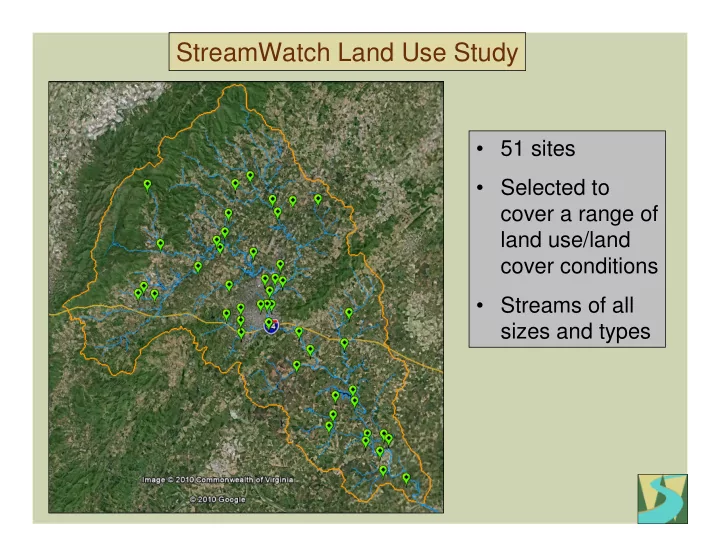

StreamWatch Land Use Study • 51 sites • Selected to cover a range of land use/land cover conditions • Streams of all sizes and types
StreamWatch Land Use Study DATA Biological • 2.5 years of bug sampling – spring 2007 through spring 2009 • Average of 6 bug samples per site • Bacteria Geomorphological • Channel dimensions, slope • Particle size (Wolman pebble count) Local Habitat • EPA rapid visual • Streambed permeability Watershed Land Use/Land Cover • LU/LC classes: impervious, forest, open land, etc. • Cattle population density • Human population density
StreamWatch Land Use Study BUG DATA • Similar to Virginia DEQ’s Virginia Stream Condition Index • Approved for use as “Level III” data by DEQ • 200 organisms per sample. Each organism ID’d to family • For analyses, we looked at average index scores, average # of families, and assessed health.
StreamWatch Land Use Study LAND USE/LAND COVER • Impervious • Forest (deciduous, evergreen, plantation) • Forest harvest • Open land • Orchard, vineyard, golf course, bare soil • Cattle population, grazed pasture • Human population
Land use/land cover conditions in 189 small Rivanna subwatersheds classified according to population density. Average Average Average Approximate % population Watershed Number of percent percent of Rivanna land density class watersheds forest impervious area (per square cover cover mile) Wild 2 1% 1 97% 0.6% Rural 26 14% 28 80% 1.0% Exurban 113 60% 86 71% 2.0% Suburban 39 21% 367 65% 5.6% Urban 9 5% 2,393 49% 25.0%
Extirpation (local extinction) correlates with land use intensity
Center for Watershed Protection’s conceptual model
General relationship between health and IC biological condition vs % impervious - 1st to 5th-order systems, not including sites near point sources (n=42) 90 average biological index score 80 R 2 = 0.82 70 60 50 40 30 20 10 0 0% 10% 20% 30% 40% 50% watershed % impervious
Comparison of SW results with conceptual model
• Impervious cover is not the only important watershed-scale factor. • In rural, exurban, and suburban systems, forest cover correlates with stream health as strongly as impervious cover. • IC and FC covary only moderately, therefore both factors should be considered when assessing risk of degradation in non-urban streams.
biological condition vs % impervious - 1st to 5th-order biological condition vs % impervious - 1st to 5th-order systems, not including sites near point sources (n=42) systems, not including sites near point sources (n=42) 90 90 average biological index score average biological index score 80 80 R 2 = 0.82 R 2 = 0.82 good 70 70 60 60 fair 50 50 40 40 30 30 20 20 poor 10 10 0 0 0% 10% 20% 30% 40% 50% 0% 5% 10% 15% 20% watershed % impervious watershed % impervious
More than half of exurban streams did not meet the Virginia aquatic life standard. 8.0 Very good or good 7.0 Assessed biological condition Virginia aquatic life standard 6.0 Fair 5.0 4.0 Poor 3.0 2.0 Rural or Wild Exurban/mixed Suburban/mixed Urban (7) (15) (11) (9) Watershed type / number of cases
Rivanna basin – predominately exurban
Cows Cattle operations, quantified at the landscape scale, showed no distinctive significant relationship with stream biological condition. The analysis is confounded somewhat by cattle/deforestation covariance. Nevertheless, cattle effects at the landscape scale seem to be of minor or negligible importance relative to impervious cover and deforestation.
Bank erosion and sediment
Riparian buffer Conditions in the riparian buffer zone correlate moderately with biological condition, and appear to mitigate landscape- scale effects to some extent.
Watershed stories Albemarle County reference stream #2 0.7 square miles • • Class – reference • Impervious - 1.0% • Forest - 99% • People/sq mile - 0 • Health - very good (76) • Sensitive bugs - 12
Watershed stories Buck Mountain Creek upper west of Rt 666 • 20.9 square miles • Class - rural/exurban • Impervious - 1.2% • Forest - 82% • People/sq mile – 50 • Health - very good (72) • Sensitive bugs - 9
StreamWatch Land Use Study Mechums River trib near Whipporwill Drive • 0.5 square miles • Class – suburban • Impervious - 5.8% • Forest - 89% • People/sq mile - 340 • Health - good (66) • Sensitive bugs - 9
Watershed stories Town Creek @ Dunlora Drive • 0.4 square miles • Class – urban • Impervious - 15.4% • Forest - 48% • People/sq mile – 1,200 • Health - fair (52) • Sensitive bugs - 6
Watershed stories Carroll Creek in Glenmore • 5.8 square miles • Class - suburban • Impervious - 4.2% • Forest - 66% • People/sq mile - 262 • Health - poor (39) • Sensitive bugs - 3
Watershed stories Rivanna trib #2 in Woodbrook • 0.5 square miles • Class – urban • Impervious - 43% • Forest - 37% • People/sq mile– 1,800 • Health - very poor (20) • Sensitive bugs - 0
Suburban Streams – 5 sensitive bugs Reference Streams – 11 sensitive bugs Exurban Streams – 7 sensitive bugs Rural Streams – 8 sensitive bugs Urban Streams – 1 sensitive bug
Recommend
More recommend